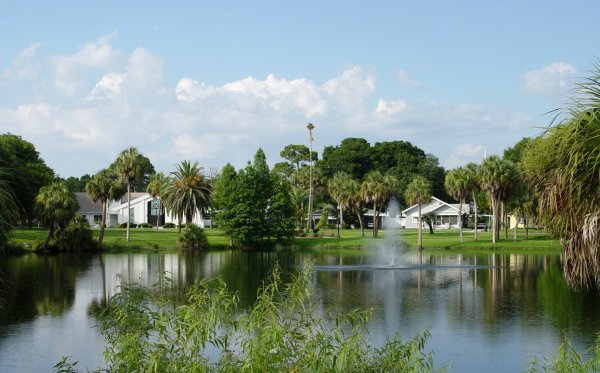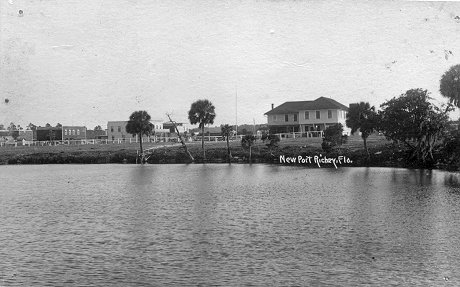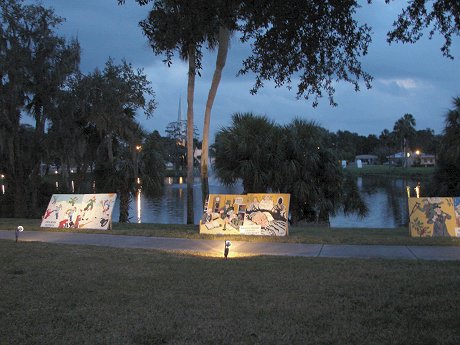HISTORY OF PASCO COUNTYOrange Lake This article was last revised on April 16, 2019. Orange Lake is believed to be a natural sinkhole. According to Elroy Avery, the lake was originally called Blue Sink. An article in the Ohio Democrat of Feb. 9, 1888, reported, “Another pretty drive is to the famous Blue Sink, one of those marvelous spots where in some past generation the land and all upon it disappeared. It is very beautiful, circular in form and filled with water blue as indigo. The banks slope gently down and all around are giant pines, that stand as grim sentinels and custodians of the secret of the spot.” In 1891 a Handbook of Florida Charles Ledyard Norton reported, “A short distance south of the Kootee is Blue Sink, a curious natural well with rocky sides.” However, a post card from about 1914 shows a Blue Sink in Elfers, and that could be the body of water referred to here. A plat map produced by the Port Richey Co. and dated 1911 calls the lake Orange Lake. In 1913 a newspaper article referred simply to “the lake in the town of Port Richey.” Presumably because the name Blue Sink was applied to numerous deep sinkholes in Florida, the name of the lake was changed. The name Orange Circle is found in a June 30, 1914, Tampa Morning Tribune article. The name Orange Lake is found in a Sept. 30, 1914, Tampa Morning Tribune article. Several 1920s post cards depicting the lake call it Mirror Lake. However, on one of the post cards, the person who wrote the caption wrote on the back that he had made a mistake, that Mirror Lake was in St. Petersburg, and that this lake was called Orange Lake. In 1921 the Dade City Banner referred to a Mirror Lake in New Port Richey, but as far as is known, the Port Richey Press and New Port Richey Press never used the name Mirror Lake, and it is believed that the lake was never actually called Mirror Lake. In a 1979 newspaper article, Wilfred T. Neill wrote, “In the early days of West Pasco settlement, the present Orange Lake was called Blue Sink. The heavily forested area around it was known as the Jungle or the Devil’s Woodyard. Local settlers, what few of them there were, despised the Jungle because cattle and hogs were forever straying off into it. At that time there were large alligators in Blue Sink (just as there are still a few in the nearby Cotee River today.) Livestock sometimes fell prey to alligators in the sinkhole, so the settlers built a fence around it.” The first sizable building to overlook Orange Lake was the Sass Hotel, constructed in 1911-1912. It had parlors, dining and dancing rooms, a veranda with a view of the lake. It also had an electric generator before the town of New Port Richey was wired for electricity. The hotel burned to the ground on the night of May 25, 1926. In the 1910s and 1920s developers in New Port Richey used the beauty of both Orange Lake and the Pithlachascotee River to attract land buyers. Both bodies of water appeared frequently in advertising and post cards. A racetrack was built around the lake. A small golf course was developed around Orange Lake in the 1920s, in part by famed golfer Gene Sarazen, who lived in New Port Richey. Frances Mallett said that the golf course was developed so that the children could have a place to play. She said that he was trying to get kids interested in golf and she recalled playing on the course when she was 12 years old. On July 5, 1929, the New Port Richey Press reported that city council passed an ordinance prohibiting swimming and fishing In Orange Lake. It was explained that the banks of the lake are being abused and that the few fish in the lake are being fast exterminated and it was felt that immediate action would be necessary to take care of the lake and its denizens. In a city election on December 3, 1935, New Port Richey voters decided by a vote of 131-29 to discontinue the golf course and use the property around Orange Lake as a park only. George R. Sims, who was one of New Port Richey’s early promoters and who donated Sims Park (then Enchantment Park) to the city, died in 1954. He was buried about 50 feet from Orange Lake, at the request of the New Port Richey city council. There was no tombstone, only a redbud tree planted to mark the spot. However, some years later his remains were moved to a cemetery. Wilfred T. Neill wrote in 1979:
According to West Pasco’s Heritage, ten religious paintings depicting scenes of the Nativity first appeared as the center of attraction at Christmas in 1957. Charles De Boer was the artist for these paintings. For the first time, in 1973, because of the energy crisis, they did not appear. The tradition of lighted Christmas cards around Orange Lake has been restored in recent years. Many of the cards were painted by students from Gulf Middle School. In 1974, on the fiftieth anniversary of the incorporation of New Port Richey, a time capsule was buried not far from the shores of Orange Lake. A polished stone set into the ground on the south side of the lake marks the place where the time capsule was buried. A fire which destroyed four businesses in downtown New Port Richey on June 3, 1987, sent lawn chemicals into nearby waterways. Several dead and sick ducks that had been in the contaminated water of Orange Lake were sent to a laboratory for toxicology tests. More than 11,000 dead fish were found in Orange Lake in the days after the fire. Some of the fish ended up in an overflow pipe at the lake and entered a storm drain under downtown New Port Richey, sending a foul smell through the streets. In 2003 the city of New Port Richey purchased the Hacienda Hotel, and in 2005 the city purchased the First Baptist Church property on Orange Lake. In January and February 2018 Orange Lake was dredged. In April 2018 New Port Richey city council hired Augustine Construction to build a boardwalk at the lake. On April 17, 2018, a group headed by Frank Starkey purchased the former First Baptist Church property from the city. It intends to construct apartments on the property.   |
